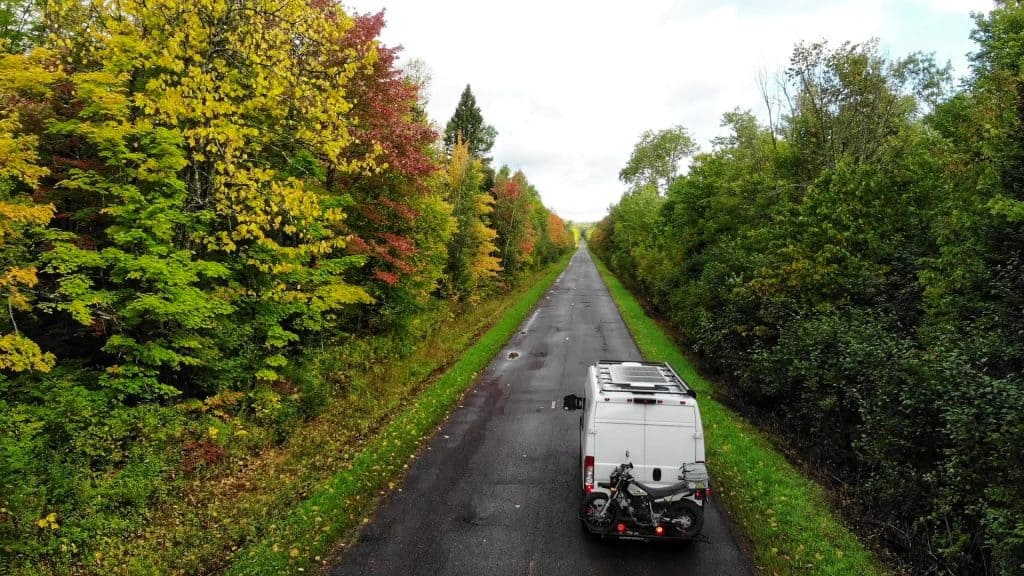
Photo: Drifter Journey
If you’re new to RV travel, you may have heard a term called dispersed camping. Dispersed camping refers to camping outside of a formal campground and doesn’t have any utility hookups like water or electricity.
Similarly, it is also called boondocking or dry camping. If you’re not familiar with the concept, it can seem intimidating to consider just going out into the woods and camping, but with these five easy steps, we will have you out exploring in no time!

Identify Public Land
Since dispersed camping doesn’t take place in a campground, you will have to do some research regarding the availability of the public land near you and its camping regulations.
As a generalization, we can break public land into two categories: Federal and State. Dispersed camping on federal land can occur in national forests managed by the United States Forest Service (USFS) or land managed by the Bureau of Land Management (BLM).
Additional public land is available that is managed by state government agencies such as Wildlife Refuges, Game Reserves, and State Forest.

The major component to be aware of when determining where you are allowed to dispersed camp, is if the land management agency allows it, and if so, do they have limits on the amount of time you can stay.
The U.S. Forest Service is managed by regional districts and each region may have different management practices in order to maintain the ecological health of the area. For example, most national forests have a 14-day stay limit, but in some high-use areas, that has been modified to two or three days.
Dispersed camping refers to camping outside of a formal campground and doesn’t have any utility hookups like water or electricity. This mostly happens on public lands, such as BLM camping and camping in national forests.

Find a Suitable Camping Spot
Once you have found an area of public land that you would like to explore, the next challenge is to find a suitable campsite. This experience will greatly depend on the type of RV that you have.
If you have a small RV, truck camper or van, it is likely that you can access and fit into most dispersed campsites. Resources like the iOverlander app or freecampsites.net provide reviews and comments from previous visitors and can give you an idea of how easy it will be for you to find a spot that you can access and actually fit your rig into.
It’s important to only camp in sites that are already established. By following this Leave No Trace guideline, we can ensure that these public lands remain open for everyone to use and enjoy in the future. Establishing new sites by simply pulling into an untracked meadow does incalculable damage to the ecosystem.
When digital reconnaissance isn’t available, you will have to do some exploring until you find a good spot. For folks who have a fifth wheel or a motorhome with a tow vehicle, sometimes it is easier to unhitch or take the toad (tow vehicle) off and look for a campsite without the burden of your big rig.
Whenever we are looking for a dispersed campsite in unfamiliar territory, we make sure to leave plenty of daylight to find one. It’s pretty much impossible to find a good spot at night!

Learn more about finding and booking campsites
Set up Camp & Enjoy
Now that you found the perfect dispersed campsite, it’s time to get settled in! Since you’re camping without hookups, you may need to get your generator or portable solar panels situated. Set up your chairs and shade canopy, get the bocce ball set out, and familiarize yourself with your site. Make sure to adhere to local fire restrictions and use the existing fire pit if there is one.
Something to be aware of when dispersed camping is power management. Many RVs are not equipped to be used without plugging into an external power source like a campground hookup or house outlet.
Do some research ahead of your trip to make sure you know how much energy your appliances use and properly equip your RV with an appropriately sized solar system or generator.
It’s also really easy to go through your clean water tanks super fast if you are used to being connected to a campground water system. Monitor your water usage and consider the option of bringing extra water with you in portable water tanks if you think you’ll need it.
If you are dispersed camping in an area where wildlife is present, Leave No Trace by not feeding the wildlife and always view the animals from a safe distance. Don’t leave coolers or food bins outside of your RV, as wildlife will get into them and make a huge mess. This also puts the wildlife in a distressing situation, making them predisposed to seeking human food and can lead to more negative wildlife/human interactions.


Leave Camp Better Than you Found It
When you’re ready to leave your site, it’s important to practice Leave No Trace principles. Make sure to pick up all of the trash in the area, even if it’s not yours.
Dispersed camping is all about enjoying nature in the most pristine condition that we can achieve, so it’s important that we all do our best to keep it that way! Bring a few extra trash bags, some rubber gloves and a picker-upper with you to make trash collection easier and more sanitary. Imagine the impact we could have if we all took five pieces of trash out of nature!
Before you pull away, walk around your site to make sure you have all of your belongings. You’d be surprised how easy it is to leave behind dog balls, kids toys and small camping accessories.



Prepare Your RV for the Next Trip
Hopefully you had a successful trip and are ready to do it all over again!
However, after camping without hookups for a few days, it is likely that you need a dump station. Again, the iOverlander app has a huge amount of information for boondockers (people who dispersed camp), including dump stations. You can typically find dump stations at campgrounds, gas stations, and truck stops, to mention a few.
Once you dump your black and gray tanks and refill your fresh water tank, you can head on to your next destination!
Come along with Drifter Journey to find free camping and hot springs

We’ve compiled a list of our favorite apps and websites to help you find dispersed camping sites with ease. Enter your email address below and it’ll hit your inbox and you can start your search.
| Cookie | Duration | Description |
|---|---|---|
| cookielawinfo-checkbox-analytics | 11 months | This cookie is set by GDPR Cookie Consent plugin. The cookie is used to store the user consent for the cookies in the category "Analytics". |
| cookielawinfo-checkbox-functional | 11 months | The cookie is set by GDPR cookie consent to record the user consent for the cookies in the category "Functional". |
| cookielawinfo-checkbox-necessary | 11 months | This cookie is set by GDPR Cookie Consent plugin. The cookies is used to store the user consent for the cookies in the category "Necessary". |
| cookielawinfo-checkbox-others | 11 months | This cookie is set by GDPR Cookie Consent plugin. The cookie is used to store the user consent for the cookies in the category "Other. |
| cookielawinfo-checkbox-performance | 11 months | This cookie is set by GDPR Cookie Consent plugin. The cookie is used to store the user consent for the cookies in the category "Performance". |
| viewed_cookie_policy | 11 months | The cookie is set by the GDPR Cookie Consent plugin and is used to store whether or not user has consented to the use of cookies. It does not store any personal data. |